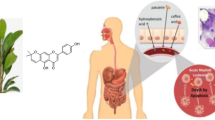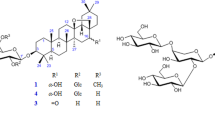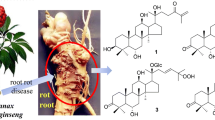Abstract
Four lignans, meso-dihydroguaiaretic acid (DHGA), macelignan, fragransin A2 and nectandrin B, were isolated from the seeds of Myristica fragrans (Vietnamese nutmeg) and investigated for their cytotoxic activity against eight cancer cell lines. Of these, DHGA exhibited potent cytotoxicity against H358 with IC50 value of 10.1 μM. In addition, DHGA showed antitumor activity in allogeneic tumor-bearing mice model.
Similar content being viewed by others
Avoid common mistakes on your manuscript.
Introduction
There are about 120 species in the genus Myristica in the world, distributed in southern Asia (Zhao and Xiao 2010). Myristica fragrans (Myristicaceae) is widely cultivated in the Southern Vietnam and vernacularly known as “Nhuc Dau Khau” (Loi 1999; Bich 2004). The seeds of this plant, known as nutmeg or mace, are generally used as a spice and cosmetic ingredient, and utilized as a traditional remedy for diarrhea, anorexia, and gastrointestinal disorder (Zhao and Xiao 2010). Several studies have reported on the chemical constituents of nutmeg (mainly Indonesian and Indian products) that the seeds contain about 30 % fat, 5–15 % volatile oil, and lignans (Braz Fo et al. 1984; Hattori et al. 1987a; Li and Yang 2007). Nutmeg and its lignan constituents have reported to possess anti-bacterial, anti-inflammatory, anticancer, anti-diabetes, and hepatoprotective, neuroprotective activities (Paul et al. 2013), recently, it has also been shown to inhibit protein tyrosine phosphatase 1B (Yang et al. 2006). In particular, dihydroguaiaretic acid (DHGA), one of the lignans in M. fragrans, was demonstrated to have cytotoxic activity against A549 lung carcinoma cells (Davis et al. 2009). Although lignans have been reported to have cytotoxic activity in several cancer cells, the antitumor effect in animal model has rarely been investigated. Recollection of the plant materials has enabled us to further investigate the chemistry of Vietnamese species, as well as obtain four lignans in sufficient quantities for antitumor activity evaluation. In this report, we describe the isolation of four lignans, DHGA, macelignan, fragransin A2 and nectandrin B from Vietnamese M. fragrans. The in vitro cytotoxic activity against several cancer cell lines and the antitumor effect of DHGA in allogeneic Sarcoma 180 tumor-bearing mice model are also reported.
Materials and methods
Plant material
The seeds of M. fragrans were collected in the Southern Vietnam in May 2010 and botanically identified by one of the authors (P.T.T). The seeds were sliced, dried, and deposited in the dry and dark place in the author’s laboratory (voucher specimen number VDL-027).
Extraction and isolation
Five kg samples were extracted twice with 96 % ethanol at room temperature for 2 weeks and the combined solvent was evaporated to get a dry extract (680 g). The extract was suspended in H2O and partitioned twice with n-hexane, ethyl acetate and the solvents were exhaustively removed to get n-hexane (16 g) and EtOAc fractions (460 g). The EtOAc fraction was subjected to passage over a silica gel column (20 × 30 cm) and eluted with a gradient of n-hexane–EtOAc to yield five fractions (F.1, 194 g; F.2, 107 g; F.3, 56 g; F.4, 48 g; and F.5, 55 g). A part of fraction F.3 (1 g) was separated by HPLC using a Gilson system, RP-18 column (2 × 150 mm, particle size 5 μm, Japan), mobile phase: MeOH in H2O (0–40 min: 75 → 80 %, 40–80 min: 80 → 100 %), detector UV (data channel 1 at 205 nm; data channel 2 at 280 nm) led to the isolation of compounds 1 (250 mg, tR 43 min) and 2 (76 mg, tR 72 min). The fraction F.4 (1.1 g) was also separated by HPLC using similar condition (mobile phase: MeOH in H2O, 0–60 min: 59 → 65 %, 60–65 min: 65 → 100 %) resulting in the isolation of 3 (21 mg, tR 52 min) and 4 (37 mg, tR 59 min). The isolated compounds were determined to be >95 % pure. These compounds were identified as DHGA (1), macelignan (2), fragransin A2 (3), and nectandrin B (4) (Fig. 1) by comparison of the MS and NMR data with those in the literature (Hattori et al. 1987b; Woo et al. 1987; Yang et al. 2006).
Cytotoxic activity
The cytotoxic activity of isolated compounds was tested against several human cancer cells. Employed cancer cell lines, H1299 (human non-small cell lung carcinoma), H358 (human bronchiolar lung cancer), H460 (large cell lung cancer), Hela (human cervical cancer), HepG2, KPL4, MCF-7, RD, and MDCK (Multicystic dysplastic kidney) cells were obtained from the American Type Culture Collection (ATCC), which were maintained in RPMI 1640 or IMDM that included L-glutamine (GIBCO) with 10 % FBS (GIBCO) and 2 % penicillin–streptomycin (GIBCO). Cells were cultured at 37 °C in a 5 % CO2 incubator. Viable cells were seeded in the growth medium into 96-well microtiter plates (1 × 104 cells/well) and incubated at 37 °C in a 5 % CO2 incubator. The test sample was dissolved in DMSO and adjusted to final sample concentrations ranging from 5.0 to 100 μg/mL by diluting with the growth medium. Each sample was prepared in triplicate. The final DMSO concentration was adjusted to <0.1 %. After standing for 24 h, the test sample was added to each well. The same volume of medium with 0.1 % DMSO was added to the control wells. 48 h after the test sample was added, MTT reagent was added to the each well (final concentration, 5 μg/mL). Four hour later, the plate was centrifuged for 5 min at 1500 rpm, the medium was removed, and the resulting formazan crystals were dissolved with DMSO. The optical density (O.D) was measured at 570 nm using a Titertek microplate reader (Multiskan MCC/340, Flow). The IC50 value was defined as the concentration of sample, which reduced absorbance by 50 % relative to the vehicle-treated control.
In vivo antitumor activity
The antitumor activity was evaluated by the tumor volume and survival time. Swiss mice (5–6 weeks, 20–22 g) were purchased from Japan (Shizuoka, Japan). Animals were housed 10 mice per cage, allowed access to water and food ad libitum, and maintained in a constant temperature (23 ± 1 °C) and humidity (60 ± 10 %) environment under a 12 h light/dark cycle (light on 07.30–19.30 h). Animal treatment and maintenance were carried out in accordance with the Principle of Laboratory Animal Care (NIH publication No. 85-23, revised 1985) and the Animal Care and Use Guidelines of Chungnam National University, Korea. Sarcoma cells, purchased from the American Type Culture Collection (ATCC No. CRL-1642), were maintained as monolayer cultures in MEM medium supplemented with 10 % FBS, 100 units/mL of penicillin and 100 μg/mL of streptomycin in a humidified 5 % CO2 atmosphere at 37 °C. The cells (1 × 106 cells/0.2 mL) were carefully implanted intra-dermal into the right chest of mice (n = 10, 5–6 weeks old, Orient Inc., Korea). DHGA was suspended in PBS buffer and were administered (i.p) in a volume of 0.2 mL (10, 5 and 2 mg/kg/d). Mercaptopurine (MP) was as a positive control (0.96 mg/kg/d, daily for 24 days). Administration by free water and PBS buffer (i.p) were used as control mice groups. On the day of 24th, the tumor volume, the survival rate and body weights of the mice were measured for antitumor activity (Nonaka et al. 2006).
Statistical analysis
The results are expressed as mean values ± SD Statistical analysis was performed using one-way ANOVA. A p < 0.05 was considered statistically significant.
Results and discussion
To assess the anticancer potential of Vietnamese nutmeg, the isolates were tested in vitro cytotoxicity against various cancer cell lines, H1299, H358, H460, Hela, HepG2, KPl4, MCF7, and RD. As shown in Table 1, DHGA showed potent cytotoxic activities against most of the cancer cells with IC50 values of 10.1 μM (H358), 15.1 μM (HepG2), 16.7 μM (RD), 16.9 μM (MCF7), 22.1 μM (KPL4), 27.7 μM (H1299, and H460), and over 30.0 μM (Hela). Macelignan also exhibited potent cytotoxicity against H358 and Hela cancer cells with IC50 values of 10.2 and 25.1 μM, respectively. Fragransin A2 showed weak inhibitory activity, and nectandrin B displayed weak inhibitory activity, except for HepG2 (IC50 27.7 μM). Taxol, a reference compound, displayed cytotoxicity against all cancer cells with IC50 values ranging from 4.9 to 6.6 μM. On the other hand, DHGA did not show cytotoxicity against MDCK normal cells (data not show), indicating that this lignan might possess selective anticancer activity. The diarylbutan lignans such as DHGA and macelignan showed stronger cytotoxic activity than dimethyl-tetrahydrofuran lignans, fragransin A2 and nectandrin B.
Since DHGA showed the most potent cytotoxicity, its antitumor effect on Sarcoma 180 tumor-bearing mice was examined to assess effectiveness on solid tumor. The tumor volumes of two control groups which were received water and PBS increased dramatically day by day in comparison to vehicle treated control mice (p < 0.05). In the case of DHGA, it was orally administered to Sarcoma 180-treated mice at doses of 10, 5, and 2 mg/kg daily from 1 day before tumor inoculation. The tumor growth was evaluated by tumor volume, in which the tumor volume was reduced by 7.4 % (2 mg/kg), 49.5 % (5 m/kg), and 71.9 % (10 mg/kg), compared to the water treated group (p < 0.05), as well as 7.7 % (2 mg/kg), 51.3 % (5 m/kg), and 74.6 % (10 mg/kg), compared to the PBS treated group (p < 0.05) (Fig. 2A). No loss of body weight was observed at any concentration after 21 days (data not shown) confirming the low toxicity of DHGA. As a positive control, mercaptopurine (MP) at 0.96 mg/kg reduced the tumor volume to about 25 % as compared to the both of control groups (p < 0.05) (Fig. 2A). Additionally, the survivals of Sarcoma 180 tumor bearing mice, with or without DHGA were monitored up to 60 days after tumor inoculation. As shown in Fig. 2B, the life span of mice fed the MP and DHGA were significantly prolonged, compared with both control groups. In the case of MP and DHGA (10 mg/kg), the survival periods giving 50 % lethality were over 45 days, meanwhile, the values were about 23 days for control groups.
Anti-tumor and life span-elongation effects of DHGA in Sarcoma 180 tumor-bearing mice. A Inhibition of tumor volume by DHGA, B Change of survival rate by DHGA treatment. Sarcoma 180 cell was inoculated s.c. into mice. MP (mercaptopurine, 0.96 mg/kg), DHGA (10, 5, 2 mg/kg) were p.o. administrated to mice for 24 days starting from 1 day before inoculation. The tumor volume was determined 24 days after inoculation. Determination of the tumor volume was described in text. Data are the mean ± SEM (*p < 0.05 vs. tumor transplantation groups; **p < 0.01 vs. control group)
Previous studies have revealed the presence of lignans in Indonesian and Indian nutmegs, of which major compounds are myristicin, macelignans, and DHGA (Braz Fo et al. 1984; Hattori et al. 1987b; Yang et al. 2006; Li and Yang 2007). This work reports the chemical constituents of Vietnamese nutmeg, where the main constituents have been characterized as DHGA, macelignan, fragransin A2, and nectandrin B. Nutmegs and their oils are largely used for flavoring and in traditional medicine as stomachic, analgesics, a remedy for rheumatism, diarrhea, etc. (Zhao and Xiao 2010). Lignans from maces have been reported to show various biological activities. Continuing research on this plant, our results showed the first report on the chemical constituent of Vietnamese M. fragrans and their cytotoxic activity in several cancer cell lines. Considering that DHGA, one of the major lignans, had the most potent cytotoxicity, it was selected for further in vivo study. When DHGA was orally administered to the allogeneic tumor-bearing mice, the sizes of solid tumors were significantly reduced and the life spans of the tumor bearing mice were elongated. In summary, we demonstrated that DHGA and other three lignans, macelignan, fragransin A2, and nectandrin B, are major constituents in Vietnamese M. fragrans and they have anticancer properties.
References
Bich, D.H. 2004. Medicinal plants and animals of Vietnam, vol. II, 472–476. Hanoi: Publishing House of Science and Technology.
Braz Fo, R., N.G. de Carvalho, and O.R. Gottlieb. 1984. XVIII: eperudiendiol, glycerides and neolignans from fruits of Osteophloeum platyspermum. Planta Medica 50: 53–55.
Davis, R.A., E.C. Barnes, J. Longden, V.M. Avery, and P.C. Healy. 2009. Isolation, structure elucidation and cytotoxic evaluation of endiandrin B from the Australian rainforest plant Endiandra anthropophagorum. Bioorganic and Medicinal Chemistry 17: 1387–1392.
Hattori, M., S. Hada, Y. Kawata, Y. Tezuka, T. Kikuchi, and T. Namba. 1987a. New 2,5-bis-aryl-3,4-dimethyltetrahydrofuran lignans from the aril of Myristica fragrans. Chemical and Pharmaceutical Bulletin 35: 3315–3332.
Hattori, M., S. Hada, Y.Z. Shu, N. Kakiuchi, and T. Namba. 1987b. New acyclic bis-phenylpropanoids from the aril of Myristica fragrans. Chemical and Pharmaceutical Bulletin 35: 668–674.
Li, F., and X.W. Yang. 2007. Biotransformation of myrislignan by rat liver microsomes in vitro. Phytochemistry 69: 765–771.
Loi, D.T. 1999. Vietnamese medicinal plants and remedies, 406–408. Hanoi: Medicinal Publishing House.
Nonaka, Y., H. Shibata, M. Nakai, H. Kurihara, H. Ishibashi, Y. Kiso, T. Tanaka, H. Yamaguchi, and S. Abe. 2006. Anti-tumor activities of the antlered form of Ganoderma lucidum in allogeneic and syngeneic tumor-bearing mice. Bioscience, Biotechnology, and Biochemistry 70: 2028–2034.
Paul S, Hwang JK, Kim HY, Jeon WK, Chung C, and Han JS. 2013. Multiple biological properties of macelignan and its pharmacological implications. Archives of Pharmacal Research 36: 264–272.
Woo, W.S., H.S. Kuk, H. Wagner, and H. Lotter. 1987. The structure of macelignan from Myristica fragrans. Phytochemistry 26: 1542–1543.
Yang, S., M. Na, J.P. Jang, K.A. Kim, B.Y. Kim, N.J. Sung, W.K. Oh, and J.S. Ahn. 2006. Inhibition of protein tyrosine phosphatase 1B by lignans from Myristica fragrans. Phytotherapy Research 20: 680–682.
Zhao, Z.Z., and P.G. Xiao. 2010. Encyclopedia of Medicinal Plants, vol. 4, 332–336. Shanghai: World Publishing Corporation.
Acknowledgments
This research is funded by Vietnam National Foundation for Science and Technology Development (NAFOSTED) under Grant number 106.99.99.09. This research was also supported by a Grant from the Global R&D Center (GRDC) Program through the NRF funded by the MEST and by a Grant from the KRIBB Research Initiative Program. This research was supported by Basic Science Research Program through the National Research Foundation of Korea (NRF) funded by the Ministry of Education (2009-0093815).
Author information
Authors and Affiliations
Corresponding authors
Rights and permissions
About this article
Cite this article
Thuong, P.T., Hung, T.M., Khoi, N.M. et al. Cytotoxic and anti-tumor activities of lignans from the seeds of Vietnamese nutmeg Myristica fragrans . Arch. Pharm. Res. 37, 399–403 (2014). https://doi.org/10.1007/s12272-013-0185-4
Received:
Accepted:
Published:
Issue Date:
DOI: https://doi.org/10.1007/s12272-013-0185-4






